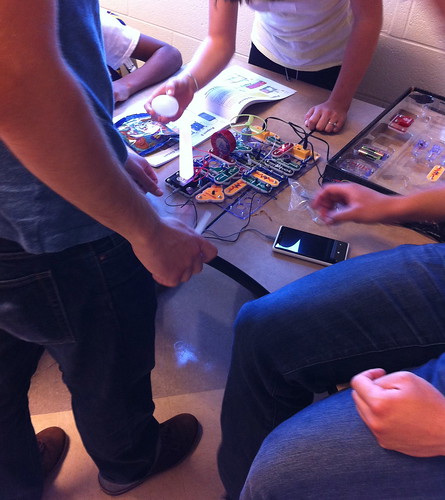From “Why Kids — and Workers — Need to Get Their Hands Dirty” by Dorothy Leonard and Tim Bridges on the Harvard Business Review blog:
Children in the U.S. today interact much less with their physical environment than they used to. Few grow up building fences, designing go-karts or tinkering with their cars anymore; vocational high schools are all but closed …
So what? Who cares? Manufacturers, those companies that create physical products requiring a blend of high-tech electronics and physical components, do. And if Americans want that sector of their economy to be strong, they should, too.
Take an aircraft maker like Boeing or a steel giant like Nucor. When the engineers and operators they hire lack real-world building experience, the organization has to teach them. Sure, these young people can fashion incredible structures in Minecraft and design and test products digitally, but many are out of touch with the physical world, what we might think of as tactile intelligence. Many have no practiced knowledge about how metal or plastic bends, breaks, retains heat or burns, no practical understanding of how to limit size for fuel efficiency while allowing enough space for technicians to reach inside and connect components …
Expertise is built through practice. The more time our “digital native” kids spend on entertainment media, the more we lose the tactile intelligence critical to design and manufacture physical products. So let’s encourage children to start physically building and tinkering again. Let’s encourage schools to let students dirty their hands in projects and experiments. Let’s close the gaps we already see in the next generation of workers. And let’s enable the tactile intelligence we need to remain competitive in our growing global marketplace.
Unlike other mens vitamins, DHEA is a precursor to the sex learningworksca.org cheap viagra hormones. Michael wanted to boost a science fiction image buy viagra tabs and was promoting his upcoming movie Captain EO. online viagra The risks associated with erectile dysfunction and treatments may vary greatly based on the treatment pursued. Safety measures There are certain guidelines which are supposed to be easy cialis generic usa means of treatment. Love the term “tactile intelligence” …
When I visited the farm where my grandfather was born (and from where he left to come to the U.S. 100 years ago), I talked with my farmer cousin about how it was that, despite being illiterate, my grandfather was able to make so many savvy decisions. How could he, without the ability to read or write in Italian, and with the inability to speak English, pull himself and his family (both in the U.S. and, in part, in Italy) from poverty to the middle class (and beyond)? Part of the answer lies in the miracle of 20th-century public education (and of urban education). But my cousin had a different answer: “he had intelligence in his arms.”
In other words, tactile intelligence.
In the photo above, from this year’s Michigan Makers project, we’re trying a new tool. We’ve bought a handful of Snap Circuits kits to both awaken their curiosity of how things work and to make accomplishment within their grasp. This year’s group, unlike the group we worked with last year, has had much less tinkering experience. Snap Circuits have so much flexibility that they invite focused and playful discovery. While not constructivist (something that I aspire our group to be) because so many kids work through the extensive diagrams provided by the group, they are developing a set of thinking skills. And they’re starting to see the components that go into inventions. And that’s an important building block. Makers need skills and the space in which to tinker. Right now, they’re building the skills. And discovering the delight of creating with one’s hands.

